This paper was presented at a colloquium entitled “Earthquake Prediction: The Scientific Challenge,” organized by Leon Knopoff (Chair), Keiiti Aki, Clarence R.Allen, James R.Rice, and Lynn R.Sykes, held February 10 and 11, 1995, at the National Academy of Sciences in Irvine, CA.
Initiation process of earthquakes and its implications for seismic hazard reduction strategy
HIROO KANAMORI
Seismological Laboratory, California Institute of Technology, Pasadena, CA 91125
ABSTRACT For the average citizen and the public, “earthquake prediction” means “short-term prediction,” a prediction of a specific earthquake on a relatively short time scale. Such prediction must specify the time, place, and magnitude of the earthquake in question with sufficiently high reliability. For this type of prediction, one must rely on some short-term precursors. Examinations of strain changes just before large earthquakes suggest that consistent detection of such precursory strain changes cannot be expected. Other precursory phenomena such as foreshocks and nonseismological anomalies do not occur consistently either. Thus, reliable short-term prediction would be very difficult. Although short-term predictions with large uncertainties could be useful for some areas if their social and economic environments can tolerate false alarms, such predictions would be impractical for most modern industrialized cities. A strategy for effective seismic hazard reduction is to take full advantage of the recent technical advancements in seismology, computers, and communication. In highly industrialized communities, rapid earthquake information is critically important for emergency services agencies, utilities, communications, financial companies, and media to make quick reports and damage estimates and to determine where emergency response is most needed. Long-term forecast, or prognosis, of earthquakes is important for development of realistic building codes, retrofitting existing structures, and land-use planning, but the distinction between short-term and long-term predictions needs to be clearly communicated to the public to avoid misunderstanding.
In a narrow sense, an earthquake is a sudden failure process, but, in a broad sense, it is a long-term complex stress accumulation and release process occurring in the highly heterogeneous Earth’s crust and mantle. The Earth’s crust exhibits anelastic and nonlinear behavior for long-term processes. In this broad sense, “earthquake prediction research” often refers to the study of this entire long-term process, with the implication that the behavior of the crust in the future should be predictable to some extent from various measurements taken in the past and at present. Pursuit of such physical processes is a respectable scientific endeavor, and significant advancements have been made on rupture dynamics, friction and constitutive relations, interaction between faults, seismicity patterns, fault-zone structures, and nonlinear dynamics.
Many recent studies, however, have demonstrated that even a very simple nonlinear system exhibits very complex behavior, suggesting that earthquake is either deterministic chaos, stochastic chaos, or both and is predictable only in a statistical sense (1). Even if the physics of earthquakes is understood well enough, the obvious difficulty in making detailed measurements of various field variables (structure, strain, etc.) in three dimensions in the Earth would make accurate deterministic predictions even more difficult. Nevertheless, a better understanding of the physics of earthquakes and an increase in the knowledge about the space-time variation of the crustal process (i.e., seismicity and strain accumulation) would allow seismologists to make useful statements on long-term behavior of the crust (2). This is often called “intermediate and long-term earthquake prediction” and is important for long-term seismic hazard reduction measures such as development of realistic building codes, retrofitting existing structures, and land-use planning. However, as urged by Allen (3), it would be better to use terms other than prediction such as “forecast” or “prognosis” for these types of statements. This distinction is especially important when issues on prediction are communicated to the general public.
For the average citizen and the public, “earthquake prediction” means prediction of a specific earthquake on a relatively short time scale—e.g., a few days (3). Such prediction must specify the time, place, and magnitude of the earthquake in question with sufficiently high reliability. For this type of prediction, one must rely on observations and identification of some short-term preparatory processes. Here we examine some observations of strain changes immediately before an earthquake.
Short-Term Strain Precursors
One of the very bases of the Japanese Tokai prediction program is the anomalous tilt observed a few hours before the 1944 Tonankai earthquake (Mw=8.1) in the epicentral area (4–7) shown in Fig. 1. This precursory change was as large as 30% of the coseismic change. Since the data are available only for the interval between 5258 and 5260 along the leveling route shown in Fig. 1c, the extent of the anomaly and the error cannot be thoroughly determined, but this is one of the rare instrumentally documented cases of crustal deformation immediately before a large earthquake. Whether this type of slow deformation is a general feature of the initiation process of an earthquake or not is an important question for short-term earthquake prediction.
Another interesting example is the slow deformation preceding the 1960 great Chilean earthquake (Mw=9.5) shown in Fig. 2a (8–10). This slow deformation is associated with an M=7.8 foreshock, which occurred ≈15 min before the main shock. This foreshock apparently had an anomalously large long-period component, which is comparable to that of the mainshock. The slow deformation presumably occurred on the down-dip extension of the seismogenic zone along the plate interface (Fig. 2b). The seismological data available in the
The publication costs of this article were defrayed in part by page charge payment. This article must therefore be hereby marked “advertisement” in accordance with 18 U.S.C. §1734 solely to indicate this fact.
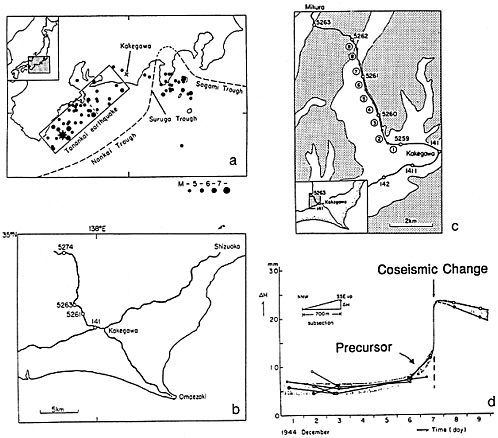
FIG. 1. Tilt precursor of the 1944 Tonankai earthquake (4–7). (a) Rupture zone of the 1944 Tonankai earthquake, (b) Leveling lines near Kakegawa. (c) Bench mark distribution along a leveling line near Kakegawa along which precursory and coseismic tilt were observed, (d) Elevation difference observed mainly for sectors 2 and 3 (between bench marks 5259 and 5260 shown in c) plotted as a function of time.
1960s, however, are limited so that this result is still subject to some uncertainty.
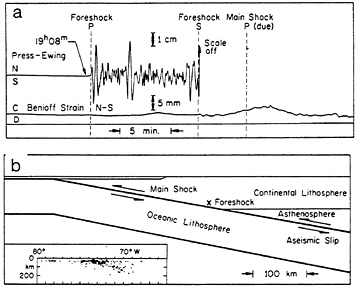
FIG. 2. A slow foreshock of the Mw=9.5 1960 Chilean earthquake (8). (a) Strain record at Pasadena (lower trace) shows slow deformation before the expected arrival time of the mainshock P wave indicated (dashed line). Upper trace is a regular seismogram showing the beginning of the foreshock. (b) Interpretation of the slow precursory source.
A recent large earthquake for which precursory slow deformation (15% of the mainshock) was suggested from the source spectrum is the 1989 Mw=8.1 Macquarie Ridge earthquake (11) (Fig. 3), although this change was not detected on the time domain record (12).
In contrast to these, many studies using close-in strain and tilt meters have concluded that precursory slip, if any, is very small, <1%, for many California earthquakes (13) such as the 1987 Whittier Narrows earthquake (14) (Mw=6.0; Fig. 4), the 1987 Superstition Hills earthquake (15) (Mw=6.6; Fig. 5), the 1989 Loma Prieta earthquake (16) (Mw=6.9;
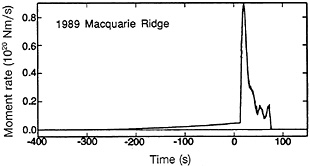
FIG. 3. Slow precursory source of the 1989 Macquarie Ridge earthquake (11). Source time function is shown by the solid curve. Time 0 refers to time of high-frequency radiation—i.e., origin time of the earthquake.
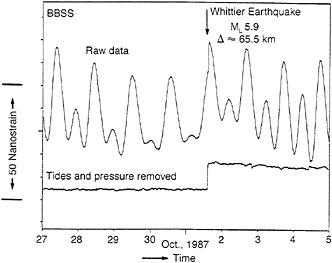
FIG. 4. Strain change associated with the 1987 Whittier Narrows earthquake (13) observed at a station 65.5 km from the epicenter.
Fig. 6), and the 1992 Landers earthquake (17) (Mw=7.3; Fig. 7).
Kedar and Kanamori (18) examined the strain energy release over a wide frequency band before the 1994 Northridge earthquake (Mw=6.7) in an attempt to determine whether any slow deformation preceded it (Fig. 8). No evidence of a slow event >0.01% of the mainshock (in terms of seismic moment) was detected. Also an examination of the strain record obtained by the Hokkaido University at ≈100 km from the epicenter of the 1993 Mw=7.8 Okushiri Island,
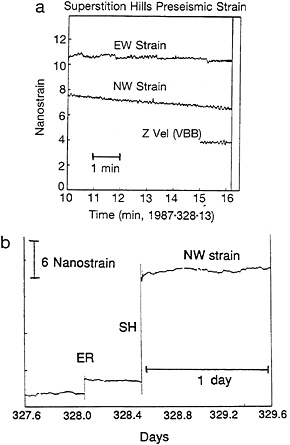
FIG. 5. Strain change associated with the 1987 Ermore Ranch and Superstion Hills earthquake observed at PFO (∆=90 km) (15). (a) Strain change immediately before the Superstition Hills earthquake. (b) Strain change associated with the Ermore Ranch and the Superstition Hills earthquake.
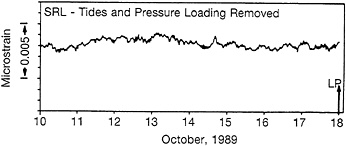
FIG. 6. Strain change before the 1989 Loma Prieta earthquake observed at distance of ≈25 km (16). The coseismic strain change at this station was 0.3-μ strain.
Hokkaido, earthquake (19) revealed no change in strain exceeding 1% of the coseismic change (Fig. 9).
Fig. 10, which summarizes these results and those summarized by Johnston et al. (20), indicates that slow precursory slip, even if it occurs, would be very difficult to detect, at least for earthquakes smaller than M=8. Some very large earthquakes may have been preceded by slow precursory deformation, but the data used for these events were still incomplete and further observations with more complete data sets would be necessary to draw a definitive conclusion. For some other large earthquakes (e.g., the 1964 Alaskan earthquake, Mw=9.2; the 1985 Mexico earthquake, Mw= 8.1), no obvious evidence for such precursory strain change has been reported; thus, we cannot expect slow precursory deformation to occur consistently before every large earthquake.
These results are not surprising in view of recent numerical studies using laboratory-derived constitutive relations. These studies predict that such precursory changes on this time scale are probably very small, <1% (in seismic moment) of the main shock (21). Shibazaki and Matsu’ura (22) suggest that the size of the nucleation zone is proportional to the earthquake size so that large earthquakes are more likely to exhibit larger slow deformation, but no definitive observational evidence is presently available.
Variations in Slip Behavior
Many seismological studies have indicated large variations in slip behavior and suggest large variations of constitutive relations for the fault-zone material. Some earthquakes are
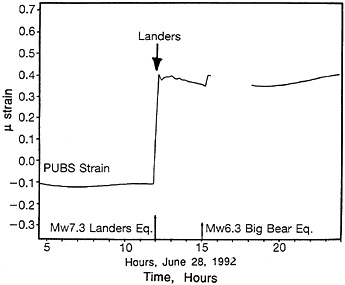
FIG. 7. Strain change associated with the 1992 Landers earthquake observed at a distance of ≈150 km (17).
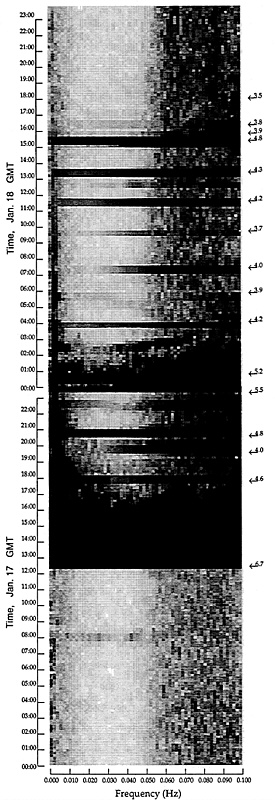
FIG. 8. Energy release associated with the 1994 Northridge earthquake (18). The spectrum (0.0–0.1 Hz) of long-period seismogram observed at Pasadena (∆=35 km) is computed for overlapping 30-min windows and plotted as a function of time. Darker areas indicate larger spectral amplitudes. Mainshock and larger aftershocks are indicated by arrows. Number attached to each arrow indicates the magnitude. Note that aftershocks with M≥3.5 can be seen over the entire frequency band. No event with a long-period spectrum comparable to events with M≥3.5 is seen before the mainshock. The event at about 8:00 is a small teleseismic event.
found to have very slow slip velocity (fault particle motion), slow rupture velocity, or both. These earthquakes are called slow earthquakes (23–28). In some extreme cases, the slip was so slow that no seismic radiation occurred (29). These events are called silent earthquakes (26, 29, 30). With the improved quality of seismological data, the evidence for the very large variation in slip behavior is becoming well established. This variation suggests that the constitutive relation (properties) of the crust is spatially very heterogeneous. Earthquakes in certain tectonic environments [e.g., in soft sediments (27, 28), in the crust with high pore pressures, below the crustal seismogenic zone (8)] may involve slow slip, which precedes or follows brittle failure. In some cases, slow deformation occurs without brittle seismic failure (29); thus, we cannot expect slow slip to be always followed by a large earthquake.
Triggering
Another important process for initiation of an earthquake is triggering by external effects. Hill et al. (31) observed significant seismic activities in many geothermal areas soon after the 1992 Landers earthquake. Although the detailed mechanism is still unknown, it appears that the interaction between fluid in the crust and strain changes caused by seismic waves from the Landers earthquake was responsible for sudden weakening of the crust (31, 32). If sudden weakening of the crust resulting from an increase in pore pressure in the crust plays an important role in triggering earthquakes (33), deterministic prediction of the initiation time of an earthquake would be difficult.
It is also possible that a small earthquake may trigger another event in the adjacent area, cascading to a much larger event. Thus, definitive prediction of the overall size of an earthquake would also be difficult. For example, in 1854, two M=8 earthquakes occurred 32 hr apart in adjacent rupture zones along the Nankai trough (Ansei Nankaido earthquakes) (5). It would be very difficult to determine why these events occurred 32 hr apart, instead of, say, a few minutes. Physically or geologically, these events can be considered a single earthquake, but whether it occurs in two distinct events 32 hr apart or in a single event would have very different social consequences.
A Strategy for Seismic Hazard Mitigation
These results demonstrate that reliable short-term earthquake prediction with seismological or geodetic means is difficult. Other precursory phenomena such as foreshocks and nonseismological anomalies (electric, ground-water anomaly, electromagnetic, etc.) may occur, but their behavior does not seem to be consistent enough to allow reliable and accurate short-term predictions. Even if some anomalies were observed, it would be difficult to determine whether they are precursors to large earthquakes.
Although short-term predictions with large uncertainties could be useful for some areas if their social and economic environments can tolerate false alarms, such predictions
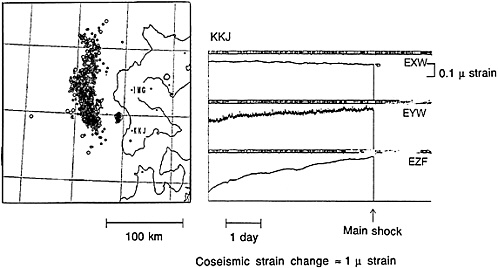
FIG. 9. Strain change associated with the 1993 Okushiri Island, Hokkaido, earthquake recorded at a distance of ≈100 km.
would be impractical for most modern industrialized cities. Then the question is, given this uncertainty, what strategy should be taken for seismic hazard reduction besides the traditional long-term hazard assessment.
A strategy for effective seismic hazard reduction is to take full advantage of the recent technical advancements in seismological methodology and instrumentation, computer, and telemetry technology. In highly industrialized communities, rapid earthquake information is critically important for emergency services agencies, utilities, communications, financial companies and media to make quick reports, and damage estimates and to determine where emergency response is most needed (34). The recent earthquakes in Northridge, California, and Kobe, Japan, clearly demonstrated the need for such information. Several systems equipped to deal with these needs have already been implemented (35, 36). With the improvement of seismic sensors and a communication system, it would be possible to increase significantly the speed and reliability of such a system so that it will eventually have the capability of estimating the spatial distribution of strong ground motion within seconds after an earthquake. Some facilities could receive this information before ground shaking begins. This would allow for clean emergency shutdown or other protection of systems susceptible to damage, such as power stations, computer systems, and telecommunication networks.
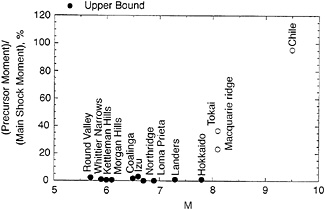
FIG. 10. Ratio of the seismic moment of precursory deformation to that of the mainshock (solid and open symbols). Solid symbol indicates upper bound. Horizontal axis is the magnitude.
This research was partially supported by U.S. Geological Survey Grant 1434–95-G-2554. This is Contribution 5555, Division of Geological and Planetary Sciences, California Institute of Technology, Pasadena, CA 91125.
1. Turcotte, D.L. (1992) Fractals and Chaos in Geology and Geophysics (Cambridge Univ. Press, Cambridge, U.K.).
2. Working Group on California Earthquake Probabilities (1995) Bull. Seismol. Soc. Am. 85, 379–439.
3. Allen, C.R. (1976) Bull Seismol. Soc. Am. 66, 2069–2074.
4. Mogi, K. (1984) Pure Appl. Geophys. 122, 765–780.
5. Mogi, K. (1985) Earthquake Prediction (Academic, Tokyo).
6. Sato, H. (1970) J.Geol. Soc. Jpn. 15, 177–180 (in Japanese).
7. Sato, H. (1977) J.Phys. Earth 25, Suppl., S115–S121.
8. Kanamori, H. & Cipar, J.J. (1974) Phys. Earth Planet. Int. 9, 128–136.
9. Kanamori, H. & Anderson, D.L. (1975) J.Geophys. Res. 80, 1075–1078.
10. Cifuentes, I.L. & Silver, P.G. (1989) J. Geophys. Res. 94, 643–663.
11. Ihmle, P.F., Harabaglia, P. & Jordan, T.H. (1993) Science 261, 177–183.
12. Kedar, S., Watada, S. & Tanimoto, T. (1994) J. Geophys. Res. 99, 17893–17907.
13. Wyatt, F.K. (1988) J. Geophys. Res. 93, 7923–7942.
14. Linde, A.T. & Johnston, M.J.S. (1989) J. Geophys. Res. 94, 9633–9643.
15. Agnew, D.C. & Wyatt, F.K. (1989) Bull. Seismol. Soc. Am. 79, 480–492.
16. Johnston, M.J.S., Linde, A.T. & Gladwin, M.T. (1990) Geophys. Res. Lett. 17, 1777–1780.
17. Johnston, M.J.S., Linde, A.T. & Agnew, D.C. (1994) Bull. Seismol. Soc. Am. 84, 799–805.
18. Kedar, S. & Kanamori, H. (1996) Bull Seismol. Soc. Am. 86, 255–258.
19. Faculty of Science, Hokkaido University (1993) Report of the Coordinating Committee for Earthquake Prediction (Hokkaido Univ., Hokkaido, Japan), Vol. 52, pp. 45–56.
20. Johnston, M.J.S., Linde, A.T., Gladwin, M.T. & Borcherdt, R.D. (1987) Tectonophysics 144, 189–206.
21. Lorenzetti, E. & Tullis, T.E. (1989) J. Geophys. Res. 94, 12343– 12361.
22. Shibazaki, B. & Matsu’ura, M. (1995) Geophys. Res. Lett. 22, 1305–1308.
23. Kanamori, H. (1972) Phys. Earth Planet. Int. 6, 346–359.
24. Sacks, I.S., Linde, A.T., Snoke, J.A. & Suyehiri, S. (1981) in Maurice Ewing Series 4: Earthquake Prediction, eds. Simpson, D.W. & Richards, P.G. (Am. Geophys. Union, Washington, DC), pp. 617–628.
25. Kanamori, H. & Kikuchi, M. (1993) Nature (London) 361, 714–716.
26. Beroza, G.C. & Jordan, T.H. (1990) J. Geophys. Res. 95, 2485–2510.
27. Linde, A.T., Suyehiro, K., Miura, S., Sacks, S.I. & Takagi, A. (1988) Nature (London) 334, 513–515.
28. Kanamori, H. & Hauksson, E. (1992) Seismol Soc. Am. 82, 2087–2096.
29. Linde, A.T. & Johnston, M.J.S. (1994) Eos, Transactions American Geophysical Union (Am. Geophys. Union, Washington, DC), Vol. 75, Suppl., p. 446.
30 Jordan, T.H. (1991) Geophys. Res. Lett. 18, 2019–2022.
31 Hill, D.P., Reasenberg, P.A., Michael, A., Arabaz, W.J., Beroza, G. (1993) Science 260, 1617–1623.
32 Linde, A.T., Sacks, S.I., Johnston, M.J.S., Hill, D.P. & Billam, R.G. (1994) Nature (London) 371, 408–410.
33 Sibson, R.H. (1992) Tectonophysics 211, 283–293.
34 Panel on Real-Time Earthquake Warning (1991) Real-Time Earthquake Monitoring-Early Warning and Rapid Response (Natl. Acad. Press, Washington, DC), pp. 1–52.
35 Kanamori, H., Hauksson, E. & Heaton, T. (1991) Eos 72, 564.
36 Nakamura, Y. (1988) in Proceedings of the Ninth World Conference on Earthquake Engineering (Kyoto), pp. 673–678.






